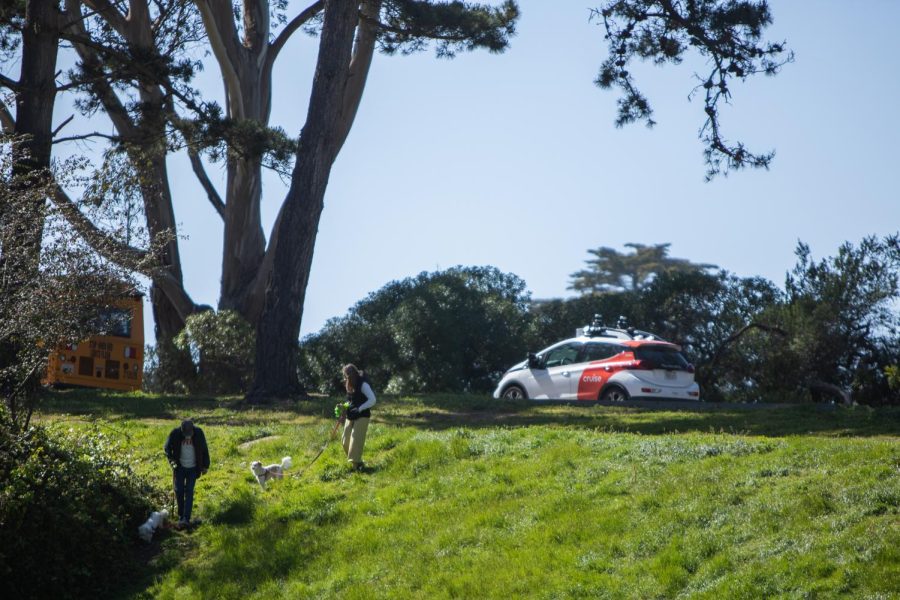Self-Driving City
Companies at the forefront of autonomous vehicle production continue to expand onto San Francisco streets with limited outside oversight.
A Cruise vehicle driving through Golden Gate Park in San Francisco, California. The company is the only one that has approved by the CPUC for rides carrying passengers without a test driver . (Oliver Michelsen / Xpress Magazine)
A Cruise vehicle with its hazards flashing slows and then comes to a stop, blocking the right lane as cars head east down Fulton. It’s dark, about 10 p.m. It’s hard to see too far ahead, but there doesn’t seem to be an accident. It’s an immobile vehicle, completely empty. No driver or passengers. Many passersby do a double take, but for San Francisco locals, instances like this have become increasingly normal. That stalled vehicle is simply one of the many self-driving cars operating on the streets of San Francisco.
If you’ve spent time driving in San Francisco, you’ve likely seen an autonomous vehicle — a car without a human operating from behind the wheel from one of three major companies. Cruise, Waymo and Zoox, owned by General Motors, Alphabet Inc. (parent company of Google) and Amazon respectively, have filled the city’s streets with self-driving, or autonomous, cars.
The vehicles, differing in design from company to company, drive mostly normal. They don’t speed; they stay between the lines on either side of the lane they’re driving in and use blinkers often. However, it remains unclear just how ready autonomous vehicles are ready for mass deployment.
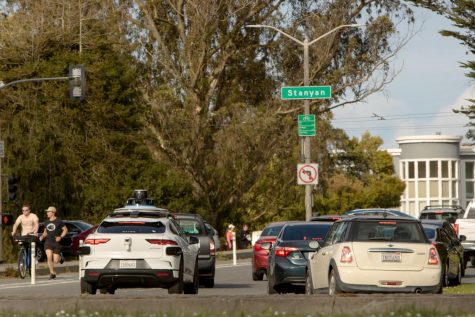
Cruise is the only company that has been approved by state organizations to charge for driverless rides. Still, the company is restricted in the hours and areas of operation. Currently, the driverless company provides rides at night on lower-density San Francisco streets with a maximum of 30 vehicles.
Collisions reported in 2022 and 2023 and traffic caused by confused AI have led to questions about public safety from San Francisco residents and public officials.
Throughout 2022, there were 134 collisions involving autonomous vehicles from Cruise, Waymo and Zoox reported to the California Department of Motor Vehicles (DMV). By May 2023, there had been 36 collisions. These collision reports are self-submitted by the AV companies to the state’s Department of Motor Vehicles and provide brief summaries of the incidents. Some are more descriptive than others. Many clarify in their final sentences, “No police were called.”
Collisions don’t tell the whole story of autonomous vehicles though.
In many of the reported cases this year, the autonomous vehicles weren’t the party at fault. In one early March collision, a car doing donuts at the intersection of Polk and Sutter struck a Cruise vehicle making a legal left turn.
From March 21 to March 23, Cruise autonomous vehicles were involved in six reported incidents. One ran into the back of a San Francisco Muni bus, while two others ran into power lines downed by March’s intense winds.
District 3 Supervisor and President of the San Francisco Board of Supervisors Aaron Peskin is working to make sure rides in autonomous vehicles are not rolled out to the public too hastily.
Peskin has said that while he and other city officials would love to “regulate the living shit out of AVs,” it largely falls outside their jurisdiction. For the most part, regulation of self-driving cars is the job of the California Public Utilities Commission (CPUC) and the National Highway Traffic Safety Administration (NHTSA).
According to a representative from the CPUC, the organization doesn’t actually authorize AV operation on public roads. That duty falls to the California DMV, which tracks the number of registered AVs in the state. The CPUC said in an email that while its jurisdiction is specifically over the transportation of passengers in AVs, any operator of vehicles without relevant DMV permits for AV vehicles could face suspension.
In November 2022, Peskin proposed a declaration of city policy in regard to autonomous vehicles. The proposition, adopted by the board of supervisors unanimously, urged these and similar organizations to “condition the granting of permits” to AV companies and prioritize San Francisco public safety.
“The city has basically said, repeatedly, we want to work with these companies, and we don’t want to fight with them,” Peskin said. “We obviously are — unlike Cruise and General Motors — not here to worry about whether or not this thing scales up and that they make $2 billion. Our job is to make sure that our public rights of way continue to function at the highest levels, and that pedestrians and motorists are safe.”
Videos on social media depict situations that vary from late-night San Franciscans playing chicken with driverless vehicles at stop signs to multiple unobstructed Cruise cars idling on an empty road with their hazards on.
Instances like these could be few and far between, but it’s difficult to tell. Tilly Chang is the executive director of the San Francisco County Transportation Authority (SFCTA). One of the main focuses of the SFCTA, outside of its “transit first” policy, is congestion management, according to Chang.
When rideshare apps like Uber and Lyft were increasing in popularity, the SFCTA determined their impact on city traffic through a partnership with Northeastern University. However, according to Chang, tracking the effects of AVs has been more difficult.
Due to different reporting requirements from different agencies and a desire to protect trade secrets, companies share little data with city transportation agencies and officials. This has led to SFCTA employees using more informal means to collect data, combing through social media and call logs to local service lines like 311 and 911.
In Cruise’s latest application to the CPUC, Chang said, they are asking to expand their services to the entire city at all hours with “an unlimited number of vehicles.”
The San Francisco Fire Department is one of the agencies that have more frequent interactions with self-driving cars in the city. An SFFD representative said the department is committed to “ensuring a safe transition related to the autonomous vehicle industry.”
The San Francisco Police Department has its own set of guidelines for engaging with and citing autonomous vehicles. Drivers operating vehicles in an autonomous-driving mode without proper permits can be cited by the police. However, no procedure has been established for pulling over or citing driverless vehicles; still, police need to respond to calls regarding AVs.
According to public records from the SFPD, officers responded to 15 instances of property damage caused by autonomous vehicles as of April 8, 2023; 14 of the 15 incidents involved Cruise vehicles.
Others have also expressed concerns about proposed fleet expansions. Mark Gruberg has been driving taxis in San Francisco for 40 years and is a board member of the San Francisco Taxi Workers Alliance (SFTWA). Nowadays Gruberg drives about two days a week and spends most of his time as an administrator.
Along with the politics that come with being a board member of the SFTWA, Gruberg also helps to run the carbon-neutral taxi company he co-founded, Green Cab. He has concerns regarding safety, particularly with the expansion by Cruise.
“It’s a promising technology,” he said. “There’s no doubt that it’s coming. There’s no doubt that it’s going to be a major portion of future transportation. But is this all premature? Are they going too fast?”
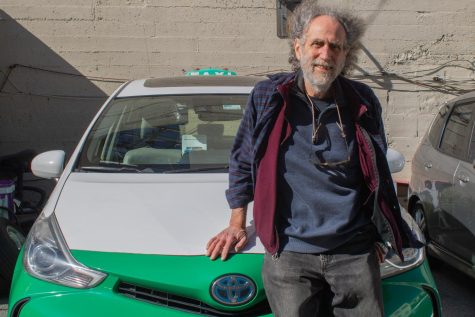
Gruberg has watched as the driver, or now non-driver, economy in San Francisco has changed dramatically. Like many other industries, it was slammed during the pandemic.
The taxi industry specifically operates on a medallion system, which means one has to have a transferable permit to own and operate a cab. These medallions can cost $250,000. Prior to the rise of ride apps and the pandemic, many drivers considered medallions a relatively safe investment in a stable industry.
Yet, according to Gruberg, some 300 drivers defaulted on their loans and lost their medallions during the pandemic. Despite the hits taken by the taxi industry, Gruberg predicts that drivers are going to be around longer than people think.
“I don’t see [AVs] as an immediate threat to cab drivers’ livelihoods,” Gruberg explained. “I think the rollout… is going to be slower than these companies would hope. In 2015, it was supposed to happen by 2018. In 2018, it was supposed to happen by 2020. Now, we’re in 2023, and we’re still at the very beginning. They still have not proved that they can operate on a large scale across the city and do that safely and efficiently.”
Gruberg also posited that any business poached by autonomous robotaxi companies would likely be coming from Uber’s and Lyft’s pool of younger clientele willing to try out the “scary technology.” Though he comes off as an old-school cabbie, he holds no illusions about the industry he works in. However, Gruberg still believes in the loyalty of his clientele and the need for human drivers.
In terms of physical assistance, autonomous vehicles simply cannot provide the same level of service human drivers can. Programs like SF Paratransit, which many taxi drivers like Gruberg participate in, provide transportation for people with mobility impairments. Though well over 70 himself, Gruberg still helps his passengers needing physical assistance, grabbing groceries or folding up walkers.
Ashley Reber is a student and musician in San Francisco and uses SF Paratransit to get to and from work and school. Reber was born with rare eye disorders that have prevented her from driving. With a mixture of low vision, uncontrollable rapid eye movements and sensitivity to light, she learned that driving was not an option for her early on.
Unlike some other passengers, Reber requires less physical assistance to get around on transit. No one needs to hold her bag or help her up small sets of stairs. She’s able to make use of the city’s audio systems that help the visually disabled navigate transit. However, she still struggles with tasks that many non-visually impaired people likely take for granted. Crossing busy intersections, reading menus and seeing which bus is approaching are challenges for Reber.
So, when she heard about self-driving services like Cruise she got interested.
With a code from the company, she was able to book a ride and experience driving by herself for the first time in her life.
“That was like a cool feeling for me because I’ve always wanted to do that,” Reber recalled. “Even if I wasn’t behind the wheel I was like, ‘I’m getting myself somewhere without like, help.’ And it was kind of like a childhood healing moment.”
Reber praised the city’s transit for its accessibility efforts but noted that she cannot rely on the fact that she’ll always live in an area with public transportation as strong as San Francisco’s.
According to some experts, fully-autonomous vehicles outside of major cities are likely still a ways away.
Dr. Zhuwei Qin is an assistant professor of Computer Engineering at SF State and studies deep learning and computer vision, two of the essential components in operating autonomous vehicles. The science of deep learning refers to the technology that allows AI to process info and react accordingly. In the field of computer vision, Qin noted that there has been major progress over the past five to six years with regard to accuracy and computational efficiency, but he feels the industry is reaching a bottleneck.
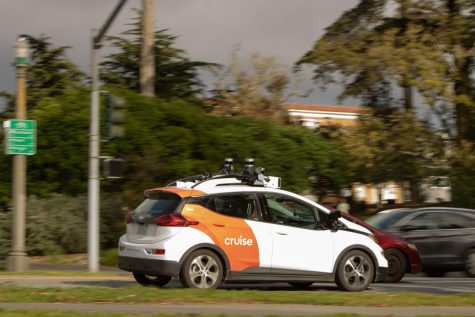
Computer vision in autonomous vehicles can be achieved through three different sensor systems. Camera, radar and LiDAR sensors all use different processes to visually map out surrounding areas for AVs. LiDAR stands for “light detection and ranging,” according to the National Oceanic and Atmospheric Administration (NOAA), which uses the technology to map shorelines and the Earth’s surface.
Teslas, the most infamous of the “self-driving” cars due in large part to its constant massive vehicle recalls, strictly use camera technology to collect visual data according to Qin.
LiDAR technology, Qin noted, while more efficient in many ways, is much more expensive. When you see a Cruise or Waymo car driving you’re likely to notice an odd-looking spinning contraption atop the vehicle. These are LiDAR transmitters and sensors, emitting rays of laser light invisible to the human eye to the surrounding area. Vehicles from Cruise and Waymo use a multiple-sensor approach to computer vision utilizing camera, radar and LiDAR technology in their vehicles.
This, in theory, makes the drive safer than say a Tesla due to the fact that the vehicles are receiving more data to make decisions on the road.
However, even these more advanced systems have limitations.
“It is extremely challenging to achieve 100 percent accuracy for computer vision-related accidents,” Qin explained. “The difference is that [Cruise and Waymo] have more data input and more information, which means they probably will eventually have higher accuracy than the Tesla self-driving car. But if they can, you know, make sure that self-driving is fully safe — I’m still in doubt about that.”
Qin suggested that the next step in safely integrating AVs onto the road might consist of these vehicles communicating with one another and their environments. Right now, self-driving cars operate as isolated systems, navigating roads solely off of data from their camera, radar and LiDAR sensors. If these isolated systems could communicate and share information with each other, then even more data would be available for the operating systems to make safer driving decisions.
Full integration of AVs in the future could materialize in the form of infrastructure like traffic lights and road boundaries that communicate with driverless vehicles. However, to Qin, this doesn’t seem to be a realistic goal at the moment.
Some Cruise AVs also seem to already be struggling with other issues. When Cruise cars are spotted pulling to the side of major roadways with their hazards flashing, they can appear to be struggling to process the situations in front of them.
Road closed signs, yellow tape and emergency services blocking lanes or rerouting traffic tend to be the hardest for these vehicles to comprehend and react to, according to the vehicles’ track records. With too many stimuli the vehicles often shut down, much like a browser with too many tabs open.
Self-driving software is seemingly being updated daily. On April 3, Cruise submitted a safety recall report to the CPUC after the incident where one of their vehicles ran into the back of a Muni bus. According to the report, the car’s vision technology at the time couldn’t comprehend or predict the movement of the “articulated” bus. An update has since been issued to the company’s fleet of 300 driverless vehicles.
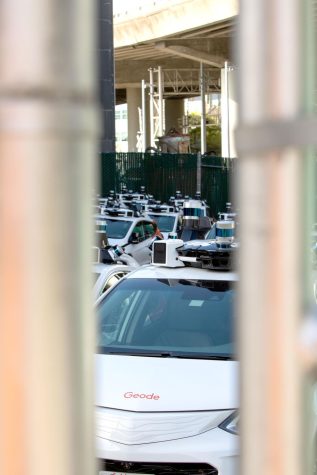
Though Cruise is currently limited to operating with 30 driverless vehicles at a time, if their application to expand services is accepted by the CPUC, the company has parking lots full of vehicles ready to be released onto San Francisco streets. According to state DMV records, Cruise has 300 registered vehicles in its driverless fleet but 700 vehicles throughout the state. Waymo follows with 301 vehicles allocated for their driverless fleet and 362 cars total.
With Cruise’s newest application to the CPUC still pending, city officials are preparing for what comes next. Peskin said that there are areas where the city can exert control.
“I think what’s next is whether or not the city is going to continue to be cooperative over issuing conditional use authorizations for electrical vehicle charging facilities… whether the city is going to be cooperative as it relates to where they can park and where they can be stored,” he said. “All of that is within our authority… if they don’t work with [us], the city’s gonna be left with no choice but to use the tools that are at its disposal to get their attention.”
Despite tensions, there’s little doubt that autonomous-vehicle technology is in the city’s future. An SFCTA representative explained that a self-driving shuttle around Treasure Island developments is already in the early stages of testing.
In the short term, Peskin said that city officials will continue to try and work with AV rideshare companies to prioritize public safety.
“I think these companies have a lot of sway in… our state capitol, and a lot of sway in our federal capital, and we’re kind of left to our own devices.”
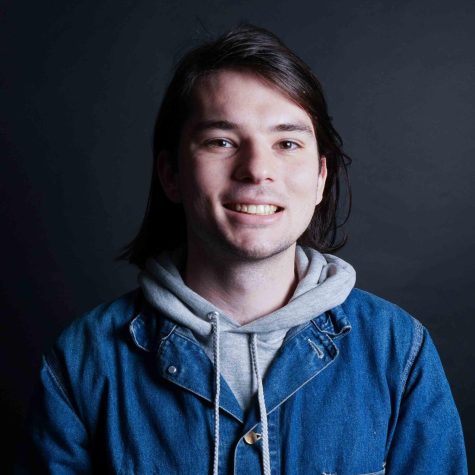
Oliver Michelsen is a fourth-year journalism student with a minor in history. Born in Virginia, he moved around frequently throughout his childhood, living...


